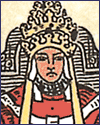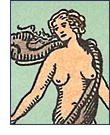|

During the Italian renaissance where liberal and freethinking minds
were flourishing, tarot cards gained immense popularity as an avenue
into the unknown and occult. The mystic art form was extremely widespread
and variants of it were rapidly manifesting themselves across the
European continent.
 It
was at this time that theories on the origins of tarot cards and
their association with playing cards were emerging. The use of cards
for purposes of fun and frivolity has been documented in varying
degrees of accuracy from the thirteenth century onward. Previously
mysticism and religious beliefs nurtured a small number of games
for children and the idle. It was not until this period of European
enlightenment during the fourteenth and fifteenth century that playing
cards were thought to have been introduced and widely documented
on. It
was at this time that theories on the origins of tarot cards and
their association with playing cards were emerging. The use of cards
for purposes of fun and frivolity has been documented in varying
degrees of accuracy from the thirteenth century onward. Previously
mysticism and religious beliefs nurtured a small number of games
for children and the idle. It was not until this period of European
enlightenment during the fourteenth and fifteenth century that playing
cards were thought to have been introduced and widely documented
on.
In truth the exact period and location of the origins of playing
cards is unknown. That the pack of tarot cards were adapted in to
a game more readily accessible and easy to use for the mass population
is however under little dispute.
 The
classic tarot deck consists of 22 Major Arcana cards and 56 Lesser
Arcana cards. The Lower Arcana cards are each sub divided in to
four suits for the purposes of reading the tarot deck. Historians
have alluded to the class system in ancient Egypt to explain their
presence. These being the Sword, Wand, Cups and finally Pentacles.
Respectively these refer to the military, agriculture, clergy and
finance. The cards were then used to predict events that surrounded
these four areas of most concern to the ancient Egyptians at this
time. Adapted to modern playing cards these suits have emerged as
Swords = Spades, Wands = Clubs, Cups = Hearts and Pentacles = Diamonds. The
classic tarot deck consists of 22 Major Arcana cards and 56 Lesser
Arcana cards. The Lower Arcana cards are each sub divided in to
four suits for the purposes of reading the tarot deck. Historians
have alluded to the class system in ancient Egypt to explain their
presence. These being the Sword, Wand, Cups and finally Pentacles.
Respectively these refer to the military, agriculture, clergy and
finance. The cards were then used to predict events that surrounded
these four areas of most concern to the ancient Egyptians at this
time. Adapted to modern playing cards these suits have emerged as
Swords = Spades, Wands = Clubs, Cups = Hearts and Pentacles = Diamonds.
The 56 Lower Arcana cards sub divide in to sets of 14 cards by
suit containing cards in numerical order from ace to ten inclusive
and court cards in ascending order from Knave (Jack) to Knight to
Queen and King. The similarities are stark and with the exception
of the Knight who has since been dropped the evolution form one
deck of cards to another is slight.
It appears the only survivor of the cull from the Major Arcana
cards is the Fool who is depicted as the wanderer. He has evolved
into the free roving Joker, again a minimal transition that closes
the circle on the modern day deck of 52 playing cards and additional
Joker.
|





